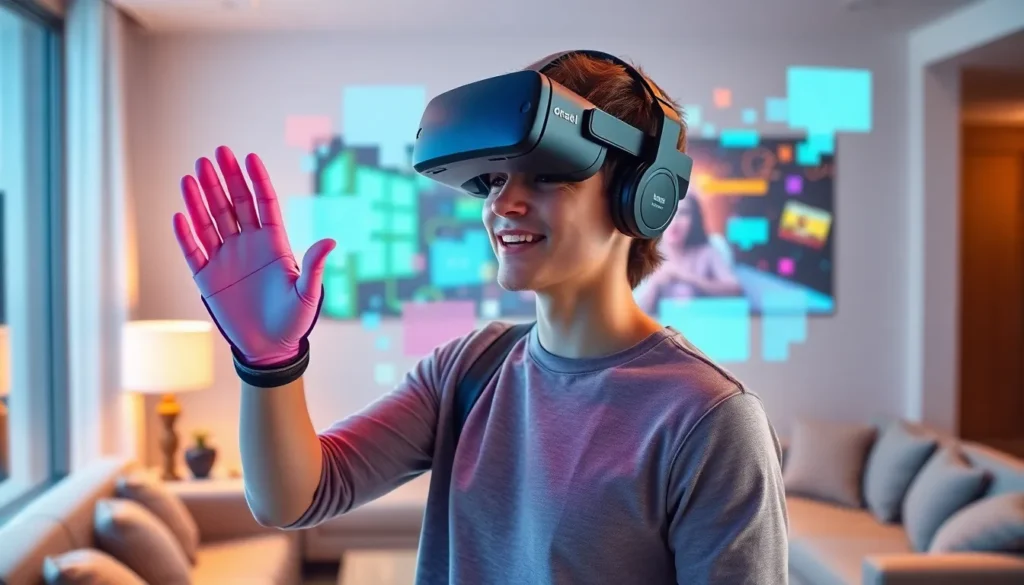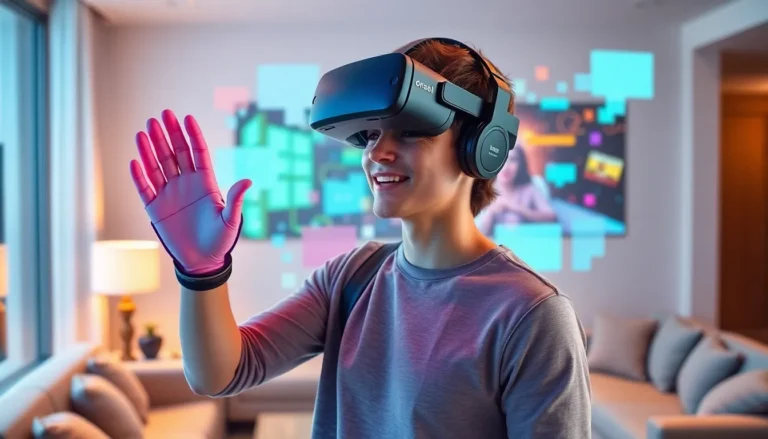Table of Contents
ToggleImagine stepping onto a construction site where hard hats and blueprints are replaced by virtual reality headsets and digital models. Welcome to the future of construction, where VR technology is revolutionizing the way projects are designed and executed. It’s not just a flashy gimmick; it’s a game-changer that’s making waves in efficiency, collaboration, and safety.
Overview of VR Technology in Construction
VR technology reshapes the construction landscape by integrating immersive experiences into workflows. This integration transforms project execution from planning to completion.
Definition and Key Concepts
VR technology enables users to interact with a computer-generated environment. Immersive simulations create realistic scenarios, allowing exploration of three-dimensional models. Participants engage with digital designs through headsets and hand controllers. Key concepts include real-time collaboration and spatial communication, enhancing project visualization. This interactive approach fosters a deeper understanding of complex structures. Architects and engineers utilize VR for detailed presentations and design reviews.
Importance in Modern Construction
Adopting VR technology significantly increases project efficiency. Teams experience improved communication, leading to fewer misunderstandings. Safety training becomes more effective, as simulated environments prepare workers for real-life scenarios. VR also simplifies design alterations; visualizing changes instantly reduces costly modifications. Stakeholders can review progress without on-site visits, saving time and resources. Integrating VR into construction practices cultivates innovation and supports sustainable design, impacting overall project success.
Applications of VR Technology in Construction
VR technology finds multiple applications within the construction industry, significantly enhancing various stages of project execution.
Design Visualization
Design visualization utilizes VR to create immersive experiences that bring architectural projects to life. Architects and designers can showcase three-dimensional models, allowing clients and stakeholders to explore layouts before construction begins. These visualizations facilitate immediate feedback, enabling quick design modifications. Users experience realistic environments, highlighting potential issues early in the design process. Enhanced visualization simplifies communication between team members and clients, ensuring everyone shares a unified vision. This approach not only improves satisfaction but also reduces costly design changes later in the project.
Project Planning and Management
Project planning and management benefit from VR through improved collaboration and efficiency. Teams can hold virtual meetings, reviewing 3D models together despite geographical distances. By simulating construction processes, stakeholders visualize timelines and resources effectively, leading to better decision-making. VR technology also aids in risk assessment; project managers identify potential hazards early, promoting proactive mitigation strategies. This capability streamlines workflows, aligns team goals, and minimizes delays. By integrating VR, construction professionals ensure all parties work effectively towards project completion, ultimately driving success.
Benefits of VR Technology in Construction
VR technology significantly enhances construction practices, offering numerous benefits that influence efficiency and project success.
Enhanced Collaboration
Collaboration among team members improves with VR technology. This technology allows architects, engineers, and clients to engage in immersive environments. Virtual meetings facilitate instant feedback and discussions, fostering clear communication. Stakeholders can visualize projects in real-time, addressing concerns before construction starts. Designers and clients no longer rely solely on 2D representations, which often leads to misunderstandings. By exploring 3D models together, teams identify potential issues early, aligning their visions. The result? Improved teamwork and a harmonious approach to project execution.
Improved Safety Training
Safety training becomes more effective through VR simulations. Workers experience realistic scenarios that prepare them for actual job site conditions. VR technology allows them to practice responses to hazards in a controlled environment. For example, employees can navigate situations involving equipment malfunctions and emergency protocols. This method enhances retention of safety practices compared to traditional training methods. Furthermore, trainees can repeat exercises until they fully grasp procedures. A safer workforce translates into fewer accidents, ultimately reducing project delays and costs.
Challenges and Limitations
VR technology presents challenges that impact its widespread adoption in construction. Understanding these limitations helps professionals navigate potential barriers.
Cost and Accessibility
Investment in VR technology can be substantial. Hardware costs, including high-quality headsets and software licensing fees, might deter smaller firms. Accessibility also varies, as high-speed internet connections are often essential for effective usage. Training personnel to utilize VR systems takes time and resources, complicating implementation for some organizations. Despite these challenges, exploring creative financing options or partnerships may help reduce expenses and enhance accessibility.
Technical Issues and Integration
Technical difficulties frequently hinder the seamless integration of VR into existing workflows. Compatibility issues with current software platforms often arise, leading to inefficiencies. Additionally, system crashes or glitches during critical project phases can disrupt productivity. Addressing these challenges requires commitment to ongoing software updates and maintenance. Training staff adequately ensures a smoother transition, reducing frustration associated with technical barriers.
Future Trends in VR Technology for Construction
Advancements in VR technology promise to reshape construction practices significantly. Enhanced hardware enables more immersive experiences, allowing users to interact with highly detailed 3D models. Improved software focuses on user-friendly interfaces, making it easier for professionals to implement VR in their workflows. Integration of artificial intelligence within VR tools streamlines design processes, identifying potential issues before they arise, leading to greater efficiency. Companies increasingly adopt wireless VR systems, promoting mobility on job sites.
Potential impacts on the construction industry are extensive. Increased collaboration occurs through shared virtual environments, fostering real-time feedback among teams. These immersive experiences save time by reducing the need for physical prototypes, shifting project timelines forward. Cost savings arise from fewer design changes, as issues are identified earlier. Enhanced safety measures through realistic training simulations lead to reduced accidents on-site. Altogether, the incorporation of VR technology cultivates more innovative, efficient, and safer construction processes.
The integration of VR technology in construction is paving the way for a more efficient and innovative industry. By enhancing collaboration and improving safety training, VR not only streamlines project execution but also fosters a deeper understanding of complex designs. As construction professionals continue to embrace this technology, they’re likely to see significant improvements in communication and project outcomes.
While challenges remain in terms of cost and accessibility, the ongoing advancements in VR hardware and software suggest a promising future. The potential for increased efficiency and safety will drive the construction industry toward adopting these transformative tools. Embracing VR technology is not just an option; it’s becoming essential for staying competitive and achieving project success in a rapidly evolving landscape.







